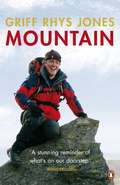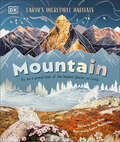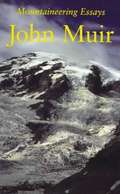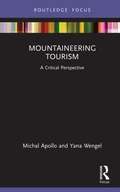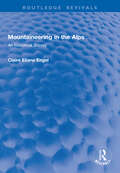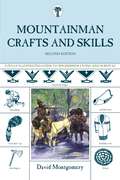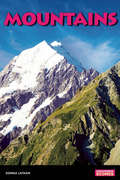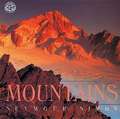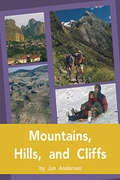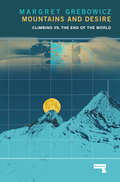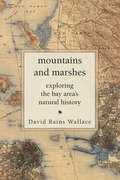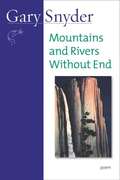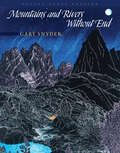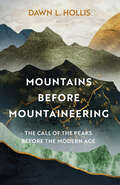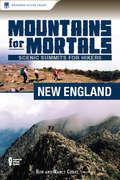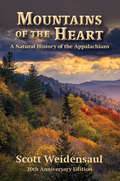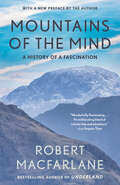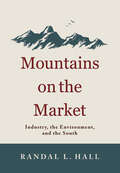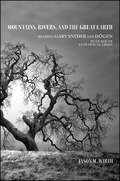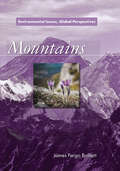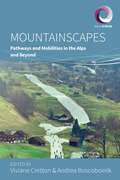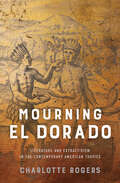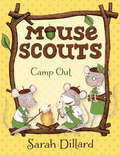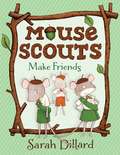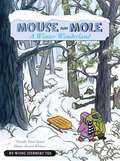- Table View
- List View
Mountain: Exploring Britain's High Places
by Griff Rhys JonesGriff Rhys Jones was a mountain virgin. So when it was suggested that he might like to go up a few of Britain’s peaks, he rightly asked: isn’t there someone better qualified? Apparently not. So Griff was duly dispatched across the rooftops of England, Scotland and Wales to explore some of the roughest, most arduous – not to mention most beautiful – terrain, and to meet those who live daily in such thin-aired wilds. Climbing the big mountains like Snowdon, Ben Nevis and Scafell Pike and many others besides gave Griff an insight into the passion and devotion our high places inspire – and turned a mountain virgin into a mountaineer. Well almost …
Mountain: Go On a Grand Tour of the Highest Places on Earth (Earth's Incredible Habitats)
by DKThis stunning book all about mountains takes children on a grand tour of the highest places on Earth.From the salt flats of the Andes to the snow-capped peak of Mount Fuji, discover 14 of the world’s most spectacular mountains and mountain ranges, and the animals and plants that live in them. The chapters cover four different types of mountains: plateaus, volcanoes, mountain ranges, and tepuis, with a selection of both famous and less-well known places within each. Every mountain or range is explored in detail, with intriguing information about its geography and flora and fauna, alongside detailed photography and beautiful illustrations. Marvel at the Great Aletsch Glacier flowing down the Alps, mountain goats scrambling across cliff faces in the Rockies, and the tiny saltwort flowers that bloom 20,000 feet up in the Himalayas. As well as the wonders of these remote areas, the threats facing mountains and their species are also investigated.Habitat: Mountains will be treasured for years to come. With foil on the cover and colorful sprayed edges, this book makes the perfect gift for any child with a passion for the natural world.
Mountaineering Essays
by John MuirThis volume contains eleven mountaineering essays that include both adventurous narrative, joyful exultation, and descriptive features such as alpine soil beds, ancient and living glaciers, and mountain sculpture. In each, Muir maintains a careful and subtle balance between the physical aspects of ascending and the more symbolic observations of the sublimity of his surroundings.
Mountaineering Tourism: A Critical Perspective (Routledge Focus on Tourism and Hospitality)
by Michal Apollo Yana WengelThis book offers a critical account of the historical evolution of mountaineering and its relation to the phenomenon of tourism, providing an overview of recent developments linked to the diversification, commodification and commercialisation of mountaineering activity. Mountaineering, broadly defined as hiking, trekking and climbing, is now a mass phenomenon, with continually growing numbers of trekkers, climbers and religious tourists hiking in mountain regions. Increasing visitor numbers require the current policies to be updated. The environments around high-mountain areas and their local resident communities, until recently cut off from civilisation, are sensitive to outside influences and have been abruptly exposed to the impact of mountaineering and related activities. This is the first book to disentangle overlapping terms and definitions related to mountaineering tourism. It identifies the key terms and turning points in mountaineering tourism and discusses the impacts of mountaineering tourism from an environmental, socio-cultural and personal perspective and identifies current tourism management policies. Finally, this book provides a continuum between the past and future of mountaineering tourism and aims to provide policy suggestions for sustainable management of fragile mountain regions. This will be of great interest to upper-level students and academics of tourism, as well as industry representatives and policymakers with an interest in adventure tourism and mountaineering.
Mountaineering in the Alps: An Historical Survey (Routledge Revivals)
by Claire Eliane EngelMountaineering in the Alps (1971) examines the two centuries of alpineering where mountaineering as we know it today was first invented and developed. It traces the first beginnings of the sport, as intrepid explorers ventured into the Alps, all the way up to the new developments of the late twentieth century.
Mountainman Crafts & Skills: A Fully Illustrated Guide To Wilderness Living And Survival
by David MontgomeryFilled with valuable information for hobbyists, survival enthusiasts, family campers - and everyone who enjoys outdoor life, Mountainman Crafts and Skills is the essential illustrated guide to wilderness living and survival. How to make your own clothing, shelter, and equipment are all covered in step-by-step detail—through illustrations by the author himself. Learn how to make and use hunting tools and utensils, wild game traps, mountainman clothing, powder flasks and horns, tents, deer-horn jewelry, and much more. Wilderness survival skills are also covered, with instruction geared at both novice and expert. Learn how to trap wild game, tan hides, shoot with black powder, make a fire, and cook a hearty meal with only the barest of essentials.
Mountains
by Donna LathamInvestigating a variety of biomes and today's natural and human threats to their preservation, this interactive series challenges young readers to look at how their own actions influence the planet's health. Four distinct environments are explored in detail, showcasing the assortment of plants and animals that inhabit these outdoor communities as well as how they have adapted to their surroundings. Offering fascinating facts on each ecosystem along with vocabulary-building sidebars, these guides show budding scientists how they can contribute towards ongoing conservation efforts. The majesty of the earth's alpine biome is captured in this guide that discusses threats such as acid rain, climate change, and habitat destruction, clearly depicting how these factors affect the world's mountains.
Mountains
by Seymour Simon"In the trademark Simon style, carefully selected color photos, drawings, and a clear and informative text tell the story of Earth's mountains: their formation, relative sizes, ecology, and influence on weather. . . . Simon may have done more than any other living author to help us understand and appreciate the beauty of our planet and our universe;
Mountains Hills and Cliffs (Rigby PM Plus Blue (Levels 9-11), Fountas & Pinnell Select Collections Grade 3 Level Q)
by Jan AndersonMountains, Hills, and Cliffs by Jan Anderson
Mountains and Desire: Climbing vs. The End of the World
by Margret GrebowiczOn the 100th anniversary of the first attempt to climb Mt Everest, Margret Grebowicz shows how and why climbing and mountaineering are still important today.In 1923, a reporter asked George Mallory why he wanted to summit Mount Everest. &“Because it&’s there&”. Today the question "why do this?" is included in nearly every mountaineering story or interview. Meanwhile, interest in climbing is steadily on the rise, from commercial mountaineering and climbing walls in university gyms and corporate workplaces to the flood of spectacular climbing imagery in advertising, cinema, and social media. Climbing has become the theater for imagining limits—of the human body and of the planet— and the nature of desire, motivation, and #goals.Covering the degradation of Everest, the banning of climbing on Australia&’s Uluru, UNESCO&’s decision to name alpinism an Intangible Cultural Heritage, the sudden death of Ueli Steck, and the commercial and critical success of Free Solo, Mountains and Desire chases after what remains of this pursuit – marred by its colonial history, coopted by nationalistic chauvinism, ableism, and the capitalist compulsion to unlimited growth – for both climbers and their fans.
Mountains and Marshes: Exploring the Bay Area's Natural History
by David Rains WallaceDescribed as "a writer in the tradition of Henry David Thoreau, John Muir, and other self-educated seers" by the San Francisco Chronicle, David Rains Wallace turns his attention to one of the most distinctive corners of California: the San Francisco Bay Area. Weaving a complex and engaging story of the Bay Area from personal, historical, and environmental threads, Wallace's exploration of the natural world takes readers on a fascinating tour through the region: from Point Reyes National Park, where an abandoned campfire and an invasion of Douglas fir trees combusted into a dangerous wildfire, to Oakland's Lake Merritt, a surprising site amid skyscrapers for some of the best local bird-watching; from the majestic Diablo Range near San Jose, where conservationists fight against land developers to preserve species like mountain lions and golden eagles, to the Golden Gate itself, the iconic bridge that-geologically speaking-leads not to gold but to serpentine. Each essay explores a different place throughout the four corners of the Bay Area, uncovering the flora and fauna that make each so extraordinary.With a naturalist's eye, a penchant for local history, and an obvious passion for the subject, Wallace's new collection is among the first nature writing dedicated entirely to the Bay Area. Informative, engrossing, and exquisitely described, Mountains and Marshes affords unexpected yet familiar views of a beloved region that, even amidst centuries of growth and change, is as dynamic as it is timeless.
Mountains and Rivers Without End
by Gary SnyderIn this work of poetry, Snyder has presented a perception of the world that has taken four decades of experience to put into words, with a powerful description of Man's relationship with the planet.
Mountains and Rivers Without End: Poem
by Gary SnyderIn simple, striking verse, legendary poet Gary Snyder weaves an epic discourse on the topics of geology, prehistory, and mythology. First published in 1996, this landmark work encompasses Asian artistic traditions, as well as Native American storytelling and Zen Buddhist philosophy, and celebrates the disparate elements of the Earth — sky, rock, water — while exploring the human connection to nature with stunning wisdom. Winner of the Bollingen Poetry Prize, the Robert Kirsch Lifetime Achievement Award, and the Orion Society's John Hay Award, among others, Gary Snyder finds his quiet brilliance celebrated in this new edition of one of his most treasured works.
Mountains before Mountaineering: The Call of the Peaks before the Modern Age
by Dawn L. HollisToday, mountains are spaces for adventure: treasured places for people to connect with nature, encounter the sublime and challenge themselves, whether it be skiing in the Italian Alps or scaling the heights of the Matterhorn in Switzerland. Some regard our love of mountains as relatively new, claiming that before modern mountaineers planted flags upon the peaks, the average European was more likely to revile and avoid a mountainous landscape than to admire it.Mountains Before Mountaineering tells a different narrative. It reveals the way mountains inspired curiosity and fascination and how they were enjoyed in sixteenth- and seventeenth-century Europe. It gives voice to the early modern travellers who climbed peaks and passes with fear and delight; to the ‘real mountaineers’ who lived and died upon the mountain slopes; and to the scientists who used mountains to try to understand the origins of the world.This book invites you on a journey through the mountains, long before Everest was ‘discovered’ as the highest mountain in the world or before the first recorded ascent of Mont Blanc. It is the story of how our love of the mountains has been a part of us from the very beginning.
Mountains for Mortals: New England
by Ron Chase Nancy ChaseAlthough New England contains three of the four most densely populated states in the country, there are still numerous natural sites to be explored in this beautiful area, and this detailed guide catalogs the most unique and scenic mountains. From Mount Katahdin in Maine to the peaks above the coastline, the finest hikes are included here, along with beautiful photographs of the land and precise directions and descriptions.
Mountains of the Heart: A Natural History of the Appalachians
by Scott WeidensaulPart natural history, part poetry, Mountains of the Heart is full of hidden gems and less traveled parts of the Appalachian Mountains Stretching almost unbroken from Alabama to Belle Isle, Newfoundland, the Appalachians are one of the oldest mountain ranges in the world. In Mountains of the Heart, renowned author and avid naturalist Scott Weidensaul shows how geology, ecology, climate, evolution, and 500 million years of history have shaped one of the continent's greatest landscapes into an ecosystem of unmatched beauty. This edition celebrates the book's 20th anniversary of publication and includes a new foreword from the author.
Mountains of the Mind: A History of a Fascination (Landscapes)
by Robert MacfarlaneCombining accounts of legendary mountain ascents with vivid descriptions of his own forays into wild, high landscapes, Robert Macfarlane reveals how the mystery of the world&’s highest places has come to grip the Western imagination—and perennially draws legions of adventurers up the most perilous slopes.His story begins three centuries ago, when mountains were feared as the forbidding abodes of dragons and other mysterious beasts. In the mid-1700s the attentions of both science and poetry sparked a passion for mountains; Jean-Jacques Rousseau and Lord Byron extolled the sublime experiences to be had on high; and by 1924 the death on Mt Everest of an Englishman named George Mallory came to symbolize the heroic ideals of his day. Macfarlane also reflects on fear, risk, and the shattering beauty of ice and snow, the competition and contemplation of the climb, and the strange alternate reality of high altitude, magically enveloping us in the allure of mountains at every level.
Mountains on the Market: Industry, the Environment, and the South (New Directions In Southern History Ser.)
by Randal L. Hall“This is a landmark not only of Appalachian history but of southern economic and environmental history as well.” —John C. Inscoe, author of Race, War, and Remembrance in the Appalachian SouthManufacturing in the Northeast and the Midwest pushed the United States to the forefront of industrialized nations during the early nineteenth century; the South, however, lacked the large cities and broad consumer demand that catalyzed changes in other parts of the country. Nonetheless, in contrast to older stereotypes, southerners did not shun industrial development when profits were possible. Even in the Appalachian South, where the rugged terrain presented particular challenges, southern entrepreneurs formed companies as early as 1760 to take advantage of the region’s natural resources.In Mountains on the Market: Industry, the Environment, and the South, Randal L. Hall charts the economic progress of the New River Valley in the Blue Ridge Mountains of southwestern Virginia, which became home to a wide variety of industries. By the start of the Civil War, railroads had made their way into the area, and the mining and processing of lead, copper, and iron had long been underway. Covering 250 years of industrialization, environmental exploitation, and the effects of globalization, Mountains on the Market situates the New River Valley squarely in the mainstream of American capitalism.“Southernists will now refer to this book first in thinking about the historical development of the extractive industries, their impact on the environment, and what it tells us about the South.” —David Brown, coauthor of Race in the American South: From Slavery to Civil Rights“An excellent microhistory of an understudied region of the Appalachian South.” —North Carolina Historical Review
Mountains, Rivers, and the Great Earth: Reading Gary Snyder and Dōgen in an Age of Ecological Crisis (SUNY series in Environmental Philosophy and Ethics)
by Jason M. WirthFINALIST for the 2017 Foreword INDIES Book of the Year Award in the Philosophy categoryMeditating on the work of American poet and environmental activist Gary Snyder and thirteenth-century Japanese Zen Master Eihei Dōgen, Jason M. Wirth draws out insights for understanding our relation to the planet's ongoing ecological crisis. He discusses what Dōgen calls "the Great Earth" and what Snyder calls "the Wild" as being comprised of the play of waters and mountains, emptiness and form, and then considers how these ideas can illuminate the spiritual and ethical dimensions of place. The book culminates in a discussion of earth democracy, a place-based sense of communion where all beings are interconnected and all beings matter. This radical rethinking of what it means to inhabit the earth will inspire lovers of Snyder's poetry, Zen practitioners, environmental philosophers, and anyone concerned about the global ecological crisis.
Mountains: Environmental Issues, Global Perspectives
by James Fargo BalliettAlways awe-inspiring, mountainous areas contain hundreds of millions of years of history, stretching back to the earliest continental landforms. This book shows how mountains are characterized by their distinctive geological, ecological, and biological conditions. Often, they are so large that they create their own weather patterns. They also store nearly one-third of the world’s freshwater—in the form of ice and snow—on their slopes. Despite their daunting size and often formidable climates, mountains are affected by growing local populations, as well as distant influences, such as air pollution and global climate change. Three detailed case studies are presented. The first shows how global warming in East Africa is harming Mount Kenya’s regional population, which relies on mountain runoff to irrigate farms for subsistence crops. The second examines the fragile ecology of the South Island Mountain in New Zealand’s Southern Alps and how development threatens the region’s endemic plant and animal species. The third discusses the impact of mountain use over time in New Hampshire’s White Mountains, where management efforts have been used to limit the growing footprint of millions of annual visitors and alpine trekkers.
Mountainscapes: Pathways and Mobilities in the Alps and Beyond (Worlds in Motion)
by Andrea Boscoboinik Viviane CrettonOften home to rural, indigenous communities, mountain regions are rapidly becoming preserves for the social elite, and altogether unsustainable within the climate crisis. Bringing together scholars from geography, sociology, anthropology, history, and urban studies, Mountainscapes seeks to re-examine the dynamics of mountain mobilities and better understand how tourism, migration, and pastoralism shape mountain communities. Ranging from the Swiss Alps to the Chilean Andes, this volume illuminates how the processes of place-making and non-belonging specifically manifest and evolve within our ever-changing mountain regions.
Mourning El Dorado: Literature and Extractivism in the Contemporary American Tropics (New World Studies)
by Charlotte RogersWhat ever happened to the legend of El Dorado, the tale of the mythical city of gold lost in the Amazon jungle? Charlotte Rogers argues that El Dorado has not been forgotten and still inspires the reckless pursuit of illusory wealth. The search for gold in South America during the colonial period inaugurated the "promise of El Dorado"—the belief that wealth and happiness can be found in the tropical forests of the Americas. That assumption has endured over the course of centuries, still evident in the various modes of natural resource extraction, such as oil drilling and mining, that characterize the region today.Mourning El Dorado looks at how fiction from the American tropics written since 1950 engages with the promise of El Dorado in the age of the Anthropocene. Just as the golden kingdom was never found, natural resource extraction has not produced wealth and happiness for the peoples of the tropics. While extractivism enriches a few outsiders, it results in environmental degradation and the subjugation, displacement, and forced assimilation of native peoples. This book considers how the fiction of five writers—Alejo Carpentier, Wilson Harris, Mario Vargas Llosa, Álvaro Mutis, and Milton Hatoum—criticizes extractive practices and mourns the lost illusion of the forest as a place of wealth and happiness.
Mouse Scouts: Camp Out
by Sarah DillardBadges are better when you earn them together! The Mouse Scouts are ready to earn a new badge . . . but can they make it in the wild without their fearless leader? The Scouts are hitting the nature trail to earn their "Camp Out" badge. But not all of the troopers are gung-ho about sleeping beneath the stars. Violet can't bear the thought of leaving her comfy bed behind, while everything about the great outdoors seems to make Junebug sneeze. But when Miss Poppy goes missing, can the Scouts work together to track down their troop leader? Brimming with lively black-and-white illustrations--including pages from the official Mouse Scout Handbook--these darling stories about the smallest Scouts with the biggest hearts are just right for fans of Ivy and Bean. "Strong characters plus lots of laughs make this a welcome series for new readers." --Kirkus Reviews
Mouse Scouts: Make Friends
by Sarah DillardBadges are better when you earn them together! The Mouse Scouts think their newest badge should be a cinch. But can old friends and new friends work side by side?When Miss Poppy assigns the troop a new badge--Making Friends--the girls think it will easy. They're already friends, so what more is there to do?! But when the Acorn Scouts learn they will need to team up with the boys in the Maple Scouts as part of the badge, everything changes. Suddenly, Tigerlily seems more interested in hanging out with her Maple Scout pal than in being friends with Violet. Friendships will be tested and opposites will find they have more in common than they thought as the Acorn Scouts figure out what it takes to be true friends.Brimming with lively black-and-white illustrations--including pages from the official Mouse Scout Handbook, plus diagrams, games, activities, and more--this darling series is just right for chapter book readers.
Mouse and Mole: A Winter Wonderland
by Wong Herbert YeeA story of two good friends in snowy winter - Mouse and Mole , who enjoy each other's company even they are not playing together.
